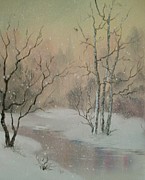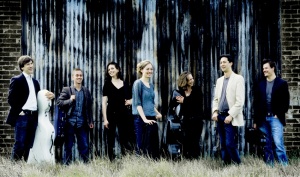As you approach the village where I live, just north of Cambridge at the edge of the fens, there’s a moment when you see two church steeples straight ahead in the distance. In fact, one of them is in my village and the other in a different village a couple of miles further away, but the flat fen landscape undoes any sense of perspective and it looks as though they simply stand side by side. As you continue up the road, the two spires slide smoothly towards each other, closer and closer, til they touch, and then with a silent ‘snap’ become identical, a single spire, crisp and clear. Then the image begins to blur again, and slowly the two steeples separate and slide apart. It’s a simple effect, easily explained, but magical when it first catches you, unawares, and still magical if, as I sometimes do, you deliberately slow down and look out for it. The exact point of union is a moment of freedom, of suspension; you don’t breathe. You’re poised on a perfect straight line running through the two steeples, and for as long as you balance on that tightrope gravity has no hold.
 Not long ago I was trying to get going on a new Piano Trio (strangely, my second this year, though I’ve never written one before in my life but have often thought of doing so). As with the violin piece Ouija which I wrote last year, the commission challenges me to find some way of drawing out improvisations from the players, within the composed design of the piece. But it’s different from Ouija, partly because I’m determined to approach the problem in as different a way as possible so that I don’t repeat myself, and partly because the challenge is different – in Ouija there was one solo performer improvising, and my means of shaping and guiding the player were both the score and the electro-acoustic tape part (which is a powerful way of guiding certain kinds of musical direction without words, almost subliminally) . Here in the trio there are no electronics, so everything must be prompted by the score. (Of course, it’s also shaped by our work together in rehearsal, and this will affect the resulting piece significantly. But in the end, I’d like it to be possible for sympathetic performers to realise the piece in their own way from the score alone, in my absence.) The other important difference is that now there are three performers, so the relations between soloist and tape in Ouija, complex as they are, start to seem simple by comparison with the three-way interactions between three musicians all thinking, reading, listening and playing together in real time. I had got stuck on how to ‘compose’ improvisation with Ouija before I eventually solved it, and I got stuck again trying to find a different answer to the problem with this piece.
Not long ago I was trying to get going on a new Piano Trio (strangely, my second this year, though I’ve never written one before in my life but have often thought of doing so). As with the violin piece Ouija which I wrote last year, the commission challenges me to find some way of drawing out improvisations from the players, within the composed design of the piece. But it’s different from Ouija, partly because I’m determined to approach the problem in as different a way as possible so that I don’t repeat myself, and partly because the challenge is different – in Ouija there was one solo performer improvising, and my means of shaping and guiding the player were both the score and the electro-acoustic tape part (which is a powerful way of guiding certain kinds of musical direction without words, almost subliminally) . Here in the trio there are no electronics, so everything must be prompted by the score. (Of course, it’s also shaped by our work together in rehearsal, and this will affect the resulting piece significantly. But in the end, I’d like it to be possible for sympathetic performers to realise the piece in their own way from the score alone, in my absence.) The other important difference is that now there are three performers, so the relations between soloist and tape in Ouija, complex as they are, start to seem simple by comparison with the three-way interactions between three musicians all thinking, reading, listening and playing together in real time. I had got stuck on how to ‘compose’ improvisation with Ouija before I eventually solved it, and I got stuck again trying to find a different answer to the problem with this piece.
Eventually I realised that the steeples were what I was looking for. I began with fully composed material which reflects a scene at subtly shifting points of perspective, perhaps a little like Monet’s serial studies of rocks or haystacks, or Rouen Cathedral. But then the piece slides into a moment of ‘eclipse’, and one of the players finds themselves free and weightless, improvising. After this I abandon any literal idea of steeples but retain the idea that double images in shifting perspectives move at various important moments into synchronicity and coincidence, and when they do, someone is freed to hover, suspended, in improvisation. When I first saw the spires I was vaguely aware of but hadn’t actually read a well-known passage in Proust’s novel Swann’s Way where Marcel sees two spires shifting and glinting, suddenly joined by a third. Unlike my fenland spires they don’t touch, but even in their slow hovering dance Proust finds a kind of awakening, an epiphany.
 My trio, Steeples Eclipse, was given a marvellous first performance by Tom Poster, Tom Hankey and Guy Johnston of the Aronowitz Ensemble a few days ago, in the Cambridge Summer Music Festival. It was fascinating working with these three fantastic players on it, hearing the improvisations take shape, and trying to find the right balance between explaining the kind of thing I envisaged, while leaving them as much room as possible to do it their way, and make it their own. The performance was wonderfully intense and I was delighted by the way that the composed parts led seamlessly into the improvisations and the conviction and spirit with which these were brought to life. I look forward very much to hearing the same group give a second performance in Oxford in the autumn (date tbc) and after that, in London.
My trio, Steeples Eclipse, was given a marvellous first performance by Tom Poster, Tom Hankey and Guy Johnston of the Aronowitz Ensemble a few days ago, in the Cambridge Summer Music Festival. It was fascinating working with these three fantastic players on it, hearing the improvisations take shape, and trying to find the right balance between explaining the kind of thing I envisaged, while leaving them as much room as possible to do it their way, and make it their own. The performance was wonderfully intense and I was delighted by the way that the composed parts led seamlessly into the improvisations and the conviction and spirit with which these were brought to life. I look forward very much to hearing the same group give a second performance in Oxford in the autumn (date tbc) and after that, in London.
